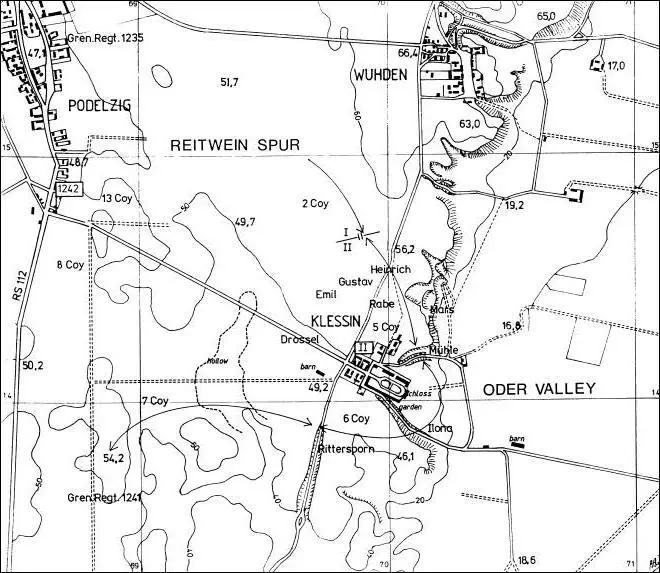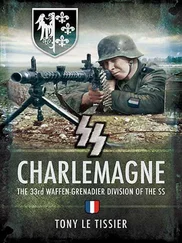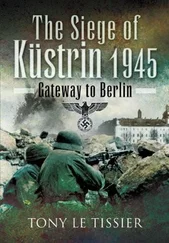The metalled road from Podelzig ran directly toward the main entrance to the house, being flanked by labourers’ cottages and outhouses either side of the approach to the courtyard entrance. This long rectangular courtyard was in turn flanked by barns, cowsheds and stables with access to the external parallel streets. A further group of cottages and outhouses lay at right-angles to the north of this formal grouping.
The owner of the Schloss, Otto von Abedyll, kept a diary from which it is clear that the Klessin Gut, or manor farm, was a prosperous concern with a variety of livestock, including dairy cattle, pigs and sheep, and considerable stocks of grain and other produce stored in its various barns. When the Red Army closed up to the line of the Oder in early February 1945, von Abedyll was able to evacuate the civilian population and most of his livestock, but the produce was lost when the area came under shellfire and the barns caught fire.
Then on the late afternoon of 15 February the Soviet 69th Army launched a surprise attack across the last of the ice into Lebus. Unheralded by the usual preparatory bombardment, two infantry divisions, supported by tanks, broke through the German lines to threaten the rear of the Reitwein Spur position, but were contained in time by elements of the Panzergrenadier-Division ‘Kurmark’ under Colonel Willy Langkeit, which had meanwhile taken over the defence of this sector. To reinforce the ‘Kurmark’ had come several two-battalion officer-cadet grenadier regiments raised from potential officers at the Reich’s various Kriegschule (KS), after which they were named. Thus the core of these units was of unusually high calibre, for the officers were instructors from these schools and the potential officers all experienced NCOs, but numbers and replacements had to be made up from all sorts, including Volkssturm.
With the ice melting, the Soviets had to resort to bridgebuilding against which the Germans turned their air and artillery resources with varying success. During the second half of February the ‘Kurmark’ received formidable artillery reinforcements and could eventually summon up to 250 guns in its support, the cooperation in providing defensive fire for the infantry working extremely well. With unusually plentiful supplies of ammunition readily available, these resources could lay up to 8,000 shells on an area of 11,000 square metres to support or quell an infantry attack. Bombardment conditions on the Reitwein Spur from the artillery of both sides were described by some First World War veterans as comparable to those experienced at Fort Douamont near Verdun in 1916. In the severe winter weather of 1945 the Wuhden and Klessin positions were of particular value as observation points.
On 2 March a night attack by elements of 8th Guards Army sweeping down the Reitwein Spur forced the German lines back to the eastern edge of Podelzig, leaving a battalion of the 1st Grenadier Regiment ‘KS Potsdam’ isolated in Wuhden, where it had to set up an all-round defence. A counterattack next day stalled under heavy Soviet fire and failed to get through. A Führer Order was then issued declaring Wuhden a ‘fortress’, which meant defending it to the last man, but it was totally unprepared for this role, its only supply resources being a potato store and a single well. Air supply was decided upon and a transport aircraft allocated for making night drops, but the Soviets promptly brought up their anti-aircraft artillery and soon rendered this means of supply impracticable. The Corps Commander, SS-General Matthias Kleinheisterkamp, then ordered an armoured thrust to relieve the garrison, but this met such a hail of anti-tank gunfire that the tanks hardly got across their start line. A subsequent dash at night by three of the ‘Brandenburg’s’ Panthers was more successful. Although one tank was knocked out and another damaged, the latter got through with the third tank, which happened to be a communications vehicle manned by radio operators and thus provided good communications for the beleaguered garrison. However, the first message out reported the majority of the battalion either dead or wounded, leaving a combatant strength of only 150–160 men. They had no medical officer with them to tend to their wounded and they were under frequent attack by Soviet infantry and being heavily shelled day and night.
Corps turned down all requests by Colonel Langkeit for permission for a break-out as being contrary to Hitler’s orders. Eventually Colonel Langkeit decided on his own responsibility to order a break-out on the 12th March, by which time the potato store and the well had been destroyed, only 80 of the original 400 men were still on their feet and the wounded had to be abandoned. Nevertheless, the ‘Kurmark’ continued to report Wuhden held for a further four days until formal permission to break out finally came through. The survivors were then rewarded with their commissions as second lieutenants and fourteen day’s leave.

The Deployment of the 2nd Battalion Fahnenjunker-Grenadier-Regiment 1242 on the 7th March 1945
The Target areas indicated are based upon interpretation of the radio log.
A similar fate was now to befall Klessin, which had also been declared a ‘fortress’ at the beginning of March while defended by elements of the Panzergrenadier Regiment ‘Kurmark’. Franz Schaberich, who was serving with that regiment, recalls assisting in the knocking down of walls to enable a Hetzer to get through the front door of the Schloss and manoeuvre into position to fire through the windows at the Soviet bridge below. Several hits from the vehicle’s 75 mm gun partially destroyed the bridge before returning fire obliged it to withdraw.
Then on 7 March, Grenadier Regiment 1242 (formerly known as the ‘KS Wetzlar’) took over the sector Point 54.2-Klessin-Alt Podelzig, its 2nd Battalion being assigned to Klessin under the command of a Captain Wiegand. The original deployment, with Grenadier Regiment 1241 (also formerly ‘KS Weslar’) on its right, was as follows:
7th Company – between Point 54.2 and Klessin
6th Company – southern front of Klessin
Bicycle Platoon – Schloss Klessin
5th Company – eastern and northern fronts of Klessin as far as the Wuhden road, where it connected with the 2nd Company of the 1st Battalion
8th Company + Mortar Platoon + 2 or 3 HMG Sections – 3–400 metres south of Klessin road junction with Reichstrasse 112
Battalion HQ – cellar on the north side of Klessin street
Three days later Captain Wiegand was sent off on a General Staff course and Lieutenant Wolfgang Schöne, commanding the 8th Company, appointed in his place, being the only officer in the battalion who had done an artillery spotting course, even though he was not the senior subaltern. One of his subsequent letters read: ‘Far right a pontoon bridge, submerged by day and refloated at night when they bring their tanks across cheekily with their headlights full on. We have to count them and report the number to Regiment. That is our main task.’
On his first afternoon in command, the Soviets advanced up the sunken road from the south with the aid of tanks to reach the Klessin-Podelzig road, but a counterattack by the regiment that evening re-opened the route and destroyed a T-34 tank. Again the following afternoon, 11 March, the Soviets in battalion strength attacked the German positions north of the hamlet and were only forced back by committing the last of the regimental reserves. That night the Soviets broke the German lines at the juncture between Grenadier Regiments 1242 and 1235 west of Wuhden and thrust south, cutting off and surrounding Klessin. Those German troops that had been fighting north of Klessin were forced back into it, adding elements of the 2nd and 3rd Companies of the 1st Battalion to the garrison strength. Only a weak and by day untenable line of positions now connected the Klessin garrison with Point 54.2 and the rest of the regiment.
Читать дальше













